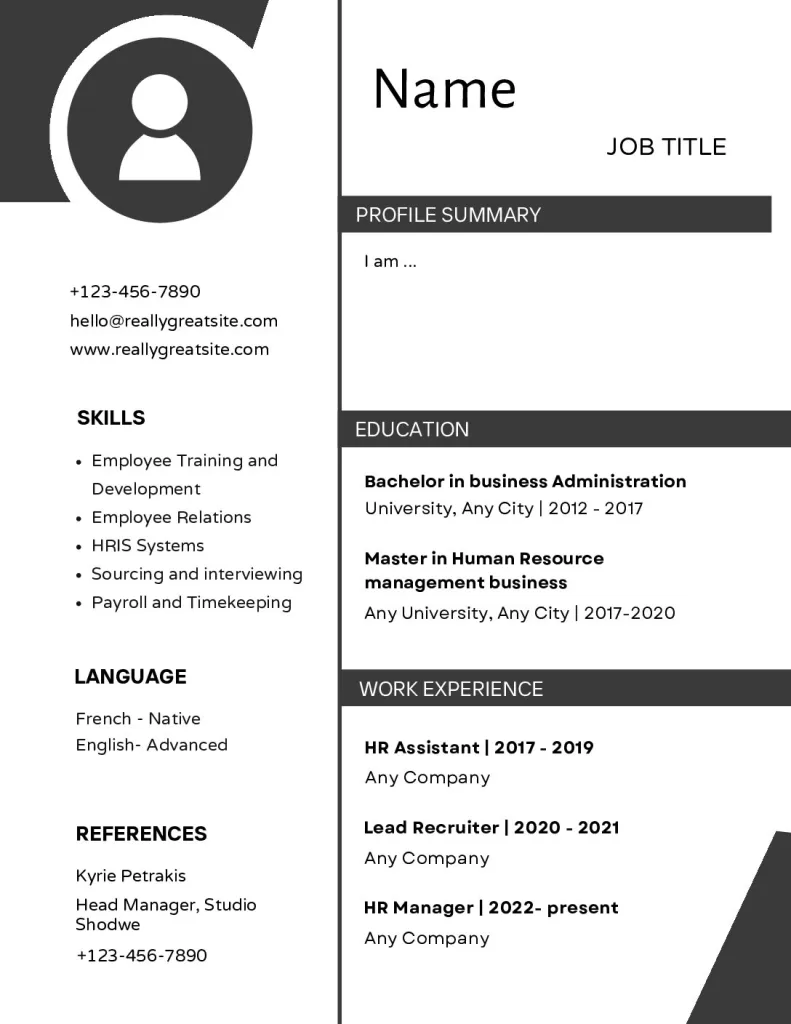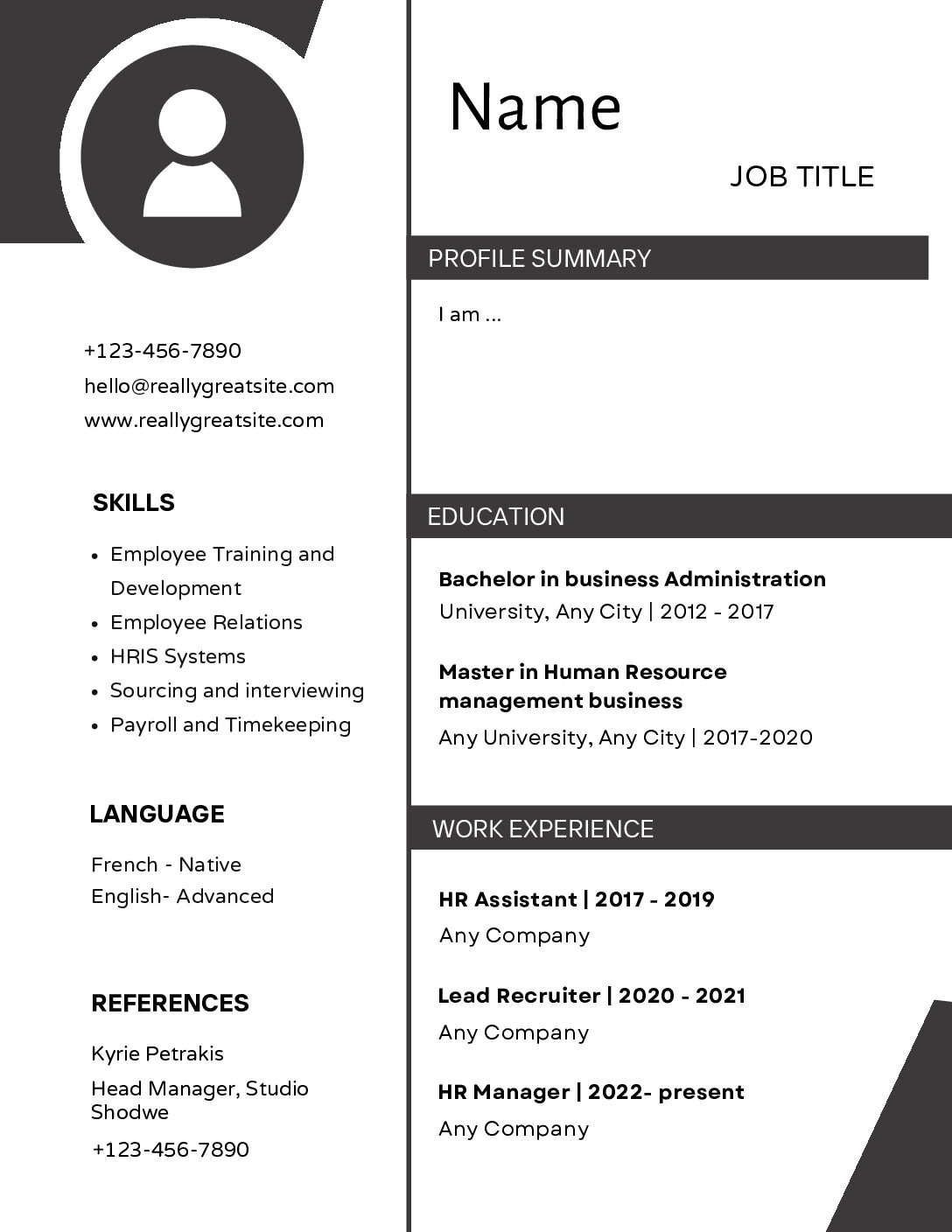A resume is a formal document used to apply for a new job. It summarizes your professional background, skills, and contact information. Crafting a well-written resume provides your first impression to potential employers and can significantly influence their decision to invite you for an interview.
What to include in a CV Resume? (11 Steps)
Step 1: Contact Information
Step 2: Professional Summary
Step 3: Work Experience
Step 4: Education History
Step 5: Skills and Languages
- Programming Languages: Python, Java, JavaScript
- Database Management: SQL, MongoDB
- Web Development: HTML/CSS, React, Angular
- Software Proficiency: Microsoft Office Suite, Adobe Creative Suite
- Network Administration: TCP/IP, DNS Management
- Communication: Effective verbal and written communication skills
- Teamwork: Ability to work well in a collaborative environment
- Problem-Solving: Strong analytical and critical thinking abilities
- Time Management: Efficiently managing multiple tasks and deadlines
- Leadership: Experience in leading teams and projects
- Adaptability: Ability to adjust to new challenges and environments
- Multilingual Proficiency: Fluent in spoken and written languages (e.g., English, Spanish, Mandarin)
- Translation Abilities: Capable of translating documents and conversations
Step 6: Certifications and Training Experience
- PMP (Project Management Professional): Demonstrates advanced knowledge and experience in project management
- AWS (Amazon Web Services) Certification: Validates cloud computing skills and knowledge
- Google Analytics Certification: Shows expertise in web analytics and data analysis
- Six Sigma Green Belt: Indicates proficiency in Six Sigma methodologies for process improvement
- CPR/First Aid Certification: Certifies ability to respond to medical emergencies
- Inventory Management System: Developed a new system that reduced waste by 20%
- Sales Growth: Led a team to increase sales by 35% over two quarters
- Training Program: Implemented a program that cut onboarding time by 50%
- Fundraising Success: Organized a fundraiser raising over $10,000 for local charities
- Employee of the Year: Recognized for exceptional customer service and dedication
Step 7: Volunteer Experience
Step 8: Formatting and Styles
- Clean Design: A resume with a simple, professional design is easier to navigate.
- Font Style: Use one font style throughout to maintain a cohesive appearance.
- Font Size: Use 10-12 point font for the body and up to 14 point for headings.
- Formatting: Apply bold and italic text sparingly to emphasize key points.
- Margins: Standard margins are between 0.5″ to 1″ for a neat look.
- Line Spacing: Use 1.15 to 1.5 line spacing for readability.
- Bullet Points: Keep lists organized and easy to scan with bullet points.
- Color: Use color strategically to highlight important sections and details.
Step 9: Tailor for Each Job
Step 10: Review and Proofread
- Read Aloud: This helps identify awkward phrasing and run-on sentences.
- Use Tools: Utilize proofreading tools like Grammarly or spell check for additional accuracy.
- Attention to Detail: Small errors can impact your chances, so review carefully.
Step 11: Save and Export Document
How to create a standout CV Resume?
A well-crafted CV resume effectively communicates your career journey, showcasing your qualifications to help you stand out in the job market.
How to Make a Resume: Video Tutorial
Watch this video tutorial to guide you through the process of creating an effective resume, including tips and tricks to make yours shine.
Steps to Create a CV Resume
- Download the Resume Template: Choose from the provided templates in PDF or Microsoft Word format. You can also edit these forms in Google Docs for flexibility.
- Start with Personal Information: Clearly list your full name, phone number, email address, and LinkedIn profile (if applicable).
- Detail Your Education History: Include your degrees, institutions, and dates of graduation. Mention any honors or relevant coursework.
- Outline Your Work Experience: List your previous positions, including job titles, company names, and employment dates. Describe your responsibilities and achievements using quantifiable metrics.
- Add Additional Skills: Highlight any specific skills that are relevant to the job you’re applying for, such as software proficiency or technical skills.
- Write a Personal Statement: Craft a brief paragraph that summarizes your qualifications, career goals, and why you’re a strong candidate for the position.


